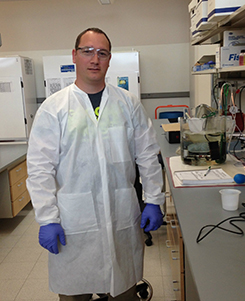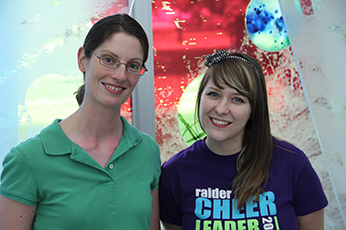
| July 2015 | |||||||||||
| Top stories | |||||||||||
| In the news | |||||||||||
| Photos | |||||||||||
| Contact us | |||||||||||
| Archive | |||||||||||
|
Teachers learn lessons as externs |
Each summer, a small number of Iowa teachers are chosen to spend six weeks in a business setting to learn how the things they teach are applied. These Real World Externships match science, technology and math teachers with businesses and agencies as part of the Governor’s STEM Advisory Council. This year the program sponsored a cadre of 39 STEM teachers, including three who were assigned to the State Hygienic Laboratory.
Barry Brill – When the teacher becomes the student
Barry Brill, a teacher for the Woodward-Granger Community School District, poses in an Ankeny laboratory.
A typical school day for Barry Brill may consist of explaining integers and quadrants to his sixth-grade math students or discussing fuel cells and terminal moraine in science class.
Brill is a middle school teacher in the Woodward – Granger Community School District. He teaches math, science and assists with football in the central Iowa community. But for six weeks this summer, the teacher is a student.
He came to the Hygienic Laboratory in Ankeny not knowing much about the public health laboratory system. A rotation model where Brill worked in several different areas of the lab with an emphasis on limnology greatly broadened his knowledge about the State Hygienic Laboratory and the services it provides to Iowa.
This firsthand experience will be a part of a lesson in which he plans to help his students make a classroom-to-lab connection. This he says may answer their common question about the courses they take: “When do people use this?”
“Much of what is done in the lab is well advanced for my classroom,” Brill said. “However many of the experimental processes that I discuss are practiced every day in the lab.
“My students learn about controls in an experiment, lab safety and reasonable results,” he adds. “The Limnology group does some classifications of fish and invertebrates. I introduce classifications and organisms of living things in my class.”
One of the program requirements for the externs is to create a lesson that can be used in the classroom setting.
“I will be applying some of what I learn to make a problem-based lesson where the students will test water samples for a variety of different factors to determine a source of a fish kill,” Brill said. “I will be including some of the steps that the lab follows to ensure their results are valid.”
Krystle Stehno – The business of public health
Krystle Stehno, a teacher with the Williamsburg Community Schools, (right) poses with Laura Clark, clinical lab analyst. The two worked on test costing and process improvement as part of Stehno’s six-week stint at the Hygienic Laboratory.
Mathematics plays a large role in a public health laboratory – some expected, some less so. Laboratory technicians, for example, routinely use math to calibrate equipment and to balance ratios between internal standards and the specimens they receive. Less common in the laboratory setting is using mathematics to paint a picture of the work performed.
This summer, Krystle Stehno is organizing complex data sets and using them to create graphics. At a glance, people can see nitrate or arsenic levels in well water through tests performed by the Hygienic Laboratory, or the number of interns, mentors, teachers and fellows who have worked in the laboratory.
Stehno uses a relatively new software program in which she inputs data and creates data visualizations that are more meaningful for the audience than a list of testing volumes.
Such projects are part of the lessons learned during Stehno’s time at the Coralville laboratory. The mathematics instructor from Williamsburg Community Schools plans to pass on these skills to her students so they understand what is required in the business world.
“I think projects like this are especially important in mathematics because oftentimes students don’t get a lot of practice with things like data collection and working with spreadsheets,” she said.
“Unfortunately, many teachers [also] don’t get a lot of experiences working in their field before they begin teaching.”
Stehno said that the most meaningful part of her externship has been learning about process improvement, data collection and data analysis.
“I thought it might be interesting to have my students test the arsenic in their private wells and look at the data from the State Hygienic Laboratory’s testing to attempt to determine any correlations between arsenic levels and public health issues,” said Stehno. “My hope is to have my students present their findings to interested members of the laboratory to receive feedback.”
Gordon Hackett – Lessons learned
Gordon Hackett from Fairfield High School observes Kris Eveland, clinical lab analyst, testing specimens for norovirus.
Gordon Hackett came to the Hygienic Laboratory in Coralville with many goals. He wanted to develop a more structured curriculum. This would include real world examples of techniques used in the lab to isolate DNA or DNA components found in viruses and bacteria. He wanted to learn contemporary lab techniques that he could share with his science and biology students at Fairfield High School.
“I have been teaching for seven years,” Hackett said. “Within that timeframe, many of the techniques I learned as a college student have been innovated and many techniques are still around. I wanted to know what tools, procedures and safety concerns a present-day lab technician uses in a laboratory setting.”
A long list of courses taught to his high school students includes biology, integrated science, biotechnology, microbiology, virology and chemistry all of which “have huge implications and carry significant weight here at the State Hygienic Laboratory,” he says.
This broad experience served him well for his six-week stint at the Hygienic Lab.
“My ultimate goal would be to develop several mini-lessons from my vast amount of experience I have had in each lab setting,” he said. “For example, in Microbiology, I was able to go through the proper procedure for gram staining for gram positive and gram negative bacteria. In the Environmental Health section, I was able to create a mass spectrometry lab, which would help students understand how specific chemicals can be identified by functional groups.”
Another takeaway lesson for Hackett from the externship applies to procedures conducted in his school lab.
“Doing a series of runs for testing organic life or chemicals does not take 45 minutes – the typical length of a standard science class,” said Hackett. “Most procedures can take up to 12 hours depending on the tests being done. Along with that, many roadblocks can occur throughout the procedure, so problem-solving skills are needed to be successful.”